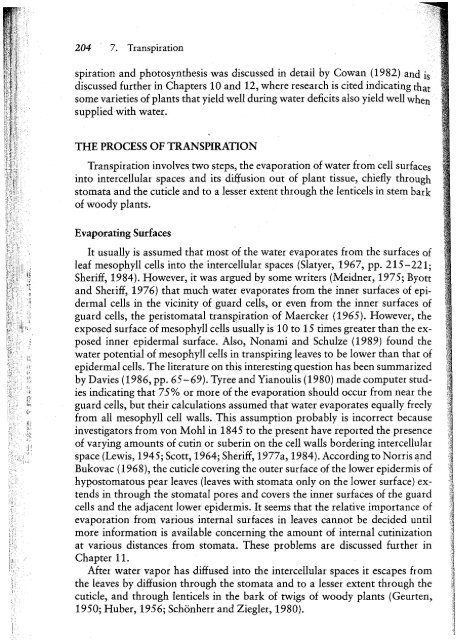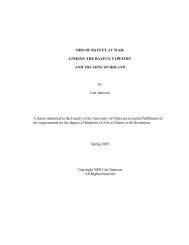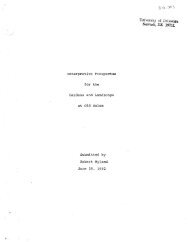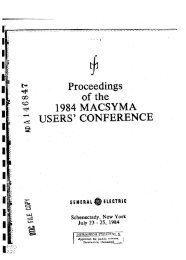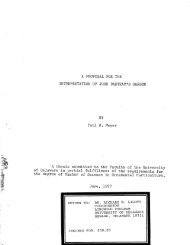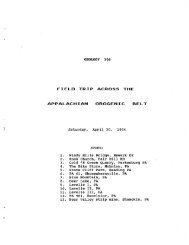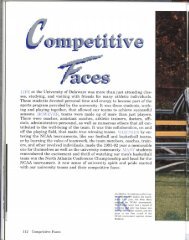Transpiration and the Ascent
Transpiration and the Ascent
Transpiration and the Ascent
You also want an ePaper? Increase the reach of your titles
YUMPU automatically turns print PDFs into web optimized ePapers that Google loves.
204 7. <strong>Transpiration</strong><br />
spiration <strong>and</strong> photosyn<strong>the</strong>sis was discussed in detail by Cowan (1982) <strong>and</strong> is<br />
discussed fur<strong>the</strong>r in Chapters 10 <strong>and</strong> 12, where research is cited indicating that<br />
some varieties ofplants that yield well during water deficits also yield well when<br />
supplied with water.<br />
THE PROCESS OF TRANSPIRATION<br />
<strong>Transpiration</strong> involves two steps, <strong>the</strong> evaporation of water from cell surfaces<br />
into intercellular spaces <strong>and</strong> its diffusion out of plant tissue, chiefly through<br />
stomata <strong>and</strong> <strong>the</strong> cuticle <strong>and</strong> to a lesser extent through <strong>the</strong> lenticels in stem bark<br />
of woody plants.<br />
Evaporating Surfaces<br />
It usually is assumed that most of <strong>the</strong> water evaporates from <strong>the</strong> surfaces of<br />
leaf mesophyll cells into <strong>the</strong> intercellular spaces (Slatyer, 1967, pp. 215-221;<br />
Sheriff, 1984). However, it was argued by some writers (Meidner, 1975; Byott<br />
<strong>and</strong> Sheriff, 1976) that much water evaporates from <strong>the</strong> inner surfaces of epidermal<br />
cells in <strong>the</strong> vicinity of guard cells, or even from <strong>the</strong> inner surfaces of<br />
guard cells, <strong>the</strong> p'eristomatal transpiration of Maercker (1965). However, <strong>the</strong><br />
exposed surface of mesophyll cells usually is 10 to 15 times greater than <strong>the</strong> exposed<br />
inner epidermal surface. Also, Nonami <strong>and</strong> Schulze (1989) found <strong>the</strong><br />
water potential of mesophyll cells in transpiring leaves to be lower than that of<br />
epidermal cells. The literature on this interesting question has been summarized<br />
by Davies (1986, pp. 65-69). Tyree <strong>and</strong> Yianoulis (1980) made computer studies<br />
indicating that 75% or more of <strong>the</strong> evaporation should occur from near <strong>the</strong><br />
guard cells, but <strong>the</strong>ir calculations assumed that water evaporates equally freely<br />
from all mesophyll cell walls. This assumption probably is incorrect because<br />
investigators from von Mohl in 1845 to <strong>the</strong> present have reported <strong>the</strong> presence<br />
of varying amounts of cutin or suberin on <strong>the</strong> cell walls bordering intercellular<br />
space (Lewis, 1945; Scott, 1964; Sheriff, 1977a, 1984). According to Norris <strong>and</strong><br />
Bukovac (1968), <strong>the</strong> cuticle covering <strong>the</strong> outer surface of <strong>the</strong> lower epidermis of<br />
hypostomatous pear leaves (leaves with stomata only on <strong>the</strong> lower surface) extends<br />
in through <strong>the</strong> stomatal pores <strong>and</strong> covers <strong>the</strong> inner surfaces of <strong>the</strong> guard<br />
cells <strong>and</strong> <strong>the</strong> adjacent lower epidermis. It seems that <strong>the</strong> relative importance of<br />
evaporation from various internal surfaces in leaves cannot be decided until<br />
more information is available concerning <strong>the</strong> amount of internal cutinization<br />
at various distances from stomata. These problems are discussed fur<strong>the</strong>r in<br />
Chapter 11.<br />
After water vapor has diffused into <strong>the</strong> intercellular spaces it escapes from<br />
<strong>the</strong> leaves by diffusion through <strong>the</strong> stomata <strong>and</strong> to a lesser extent through <strong>the</strong><br />
cuticle, <strong>and</strong> through lenticels in <strong>the</strong> bark of twigs of woody plants (Geurten,<br />
1950; Huber, 1956; SchOnherr <strong>and</strong> Ziegler, 1980).


